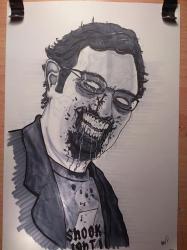It’s difficult to think of a time when the idea of invasion from Mars wasn’t in the popular cultural psyche.
From roughly 1880 onwards a handful of ‘scientific romance’ novels had involved Mars in some way, either through direct contact or humans developing some form of psychic link with people who already lived on the red planet. Encouraged in no small part by astronomer Percival Lowell and his alleged discovery of canals on the Martian surface (long story), the idea of intelligent life on another planet took hold in the minds of several authors, including a former academic by the name of Herbert George Wells.
H.G. Wells had become an author of some note in the second half of the 1890s, publishing what would go on to become science fiction classics with The Time Machine, The Invisible Man and The Island of Doctor Moreau, along with the fantasy novel The Wonderful Visit. As well as being a former biology teacher, Wells was an avowed socialist and both these streaks would come out in his next story. Originally serialised in Pearson’s Magazine in 1897, this book would take the tropes of invasion literature that had been popular for more than twenty years and literally propel them into outer space.
“Yet across the gulf of space, minds that are to our minds as ours are to those of the beasts that perish, intellects vast and cool and unsympathetic, regarded this earth with envious eyes, and slowly and surely drew their plans against us.”
Presumably set in 1900, the story opens with a description of a strange glow seen on the surface of Mars, followed by a series of ten tremendous volcanic eruptions as the planet approached its closest position with Earth. These were no natural phenomenon, but the construction of a huge mass driver and the launching of ten invasion spacecraft at the capital city of humanity’s most powerful Empire. One summer’s night, an immense metal cylinder crashes into Horsell Common in Woking, Surrey, a few miles outside of London. The unnamed Narrator (an academic and author clearly based on Wells himself) witnesses the cylinder open, revealing squat, squid-like Martians that incinerate anyone approaching their craft with a laser-like Heat Ray. When the British Army arrive and engage the Martians the following day, the Narrator witnesses the aliens’ powerful tripod Fighting Machines first hand as they stride across the landscape. After losing one of their number to artillery, the Martians resort to firing poison gas shells to subdue resistance, advancing almost unopposed towards a London desperate to flee the oncoming aliens. This rag-tag evacuation is seen from the point of view of the Narrator’s brother as he falls in with a pair of young women and the three of them try to escape to Europe.
One of the first things you notice is that the book is that the aliens are, well, alien. Unlike every story about Mars that came before it, and unlike the vast majority that followed, the aliens are just that. They aren’t little green men, or some kind of space-Aryan. They are simply brains with a heart, lungs, eyes and ear attached. Two bunches of tentacles act as both hands and feet, while the Martians feed by draining the blood from prey and injecting the nutrients into their own bloodstream. They have incredible difficulty adapting to Earth’s gravity, only offset slightly by the denser atmosphere and its richer oxygen content, and are reliant wholly on their vehicles for moving more than a few metres. They perceive the British Empire in the same way that Victorians would likely perceive a herd of wildebeest: a society of food animals taking up space that they want. Wells repeatedly drives home this point, damning European colonialism as being just as destructive as the Martians and using the eradication of Tasmanian Aborigines as an example of how humans have done exactly the same thing to each other.
Similarly is the theme of how humans react when placed under extreme stress. While the two main protagonists are (for the most) the very definition of courage under fire, three of the most prominent supporting characters are pushed to their breaking points. Mrs Elphinstone, one of the Brother’s companions, breaks down at the thought of the loss of her husband but manages to rally enough to escape from the oncoming aliens. It is the two companions of the Narrator who show us just how badly the human mind can react. The Artilleryman, probably the only survivor of the first battle between Man and Martian at Woking, goes on to lay claim to Putney Hill on the outskirts of London and tells the Narrator of his fantasies of becoming the leader of a subterranean utopia where human survivors will live in the otherwise empty sewers and subway tunnels of the London Underground. This is despite his inability to dig a tunnel more than ten feet long to accomplish this dream. But it is the Curate, a young Anglican clergyman who falls in with the Narrator after witnessing the destruction of his beloved Shepperton church, whose descent into madness is most graphically illustrated. Trapped in a ruined house, the Curate suffers a mental breakdown of a level that would be called Shell Shock less than 20 years later. After fighting with the Narrator over food supplies, the Curate finally snaps and decides to cast the Martians out with nothing more than the power of prayer. Although the Narrator manages to knock him out, his loud ranting proves to draw the Martians to their location and the unconscious Curate is taken anyway, presumably to be eaten. The Narrator himself also eventually snaps, having walked through a London that is largely deserted and strewn with corpses. Electing to end his suffering by goading the Martians into killing him, he walks directly up to a stationary Martian Tripod only to find its pilot is dead.
And of course, this leads us to the most well-known yet misquoted fact about The War of the Worlds that everyone ‘knows’: the Martians died of the common cold. They didn’t. Wells makes it perfectly clear that the Martians, having eliminated disease from their world generations earlier, have no immune system that can resist even the bacteria that cause putrefaction in the dead tissue of all living things. Essentially, from the moment they landed the Martians started to go off.
But if The War of the Worlds is to be remembered for only one thing, it should be its worryingly accurate predictions of future warfare. Okay, the Heat Ray is basically a laser and we don’t have laser weapons yet. But the Martian’s other weapons, equipment and use of technology in ‘shock and awe’ tactics are far more accurate than predictions in some of Wells’ other works, such as the ‘atomic’ bombs in The World Set Free. Many of the scenes related in this novel would be seen again writ large eighteen years after the book’s publication. World War I would see armoured fighting vehicles attacking and terrifying enemies into submission; cavalry charges rendered useless in the face of new weaponry (in reality the machine gun); and the use of poison gas to smother and subdue enemy positions.
In short, this book remains one of the most groundbreaking and influential early science fiction works. It is up there with Frankenstein and Dracula as works from the 19th Century that any self-respecting geek must read. So let it be written, so let it be done.




Nerd Comments